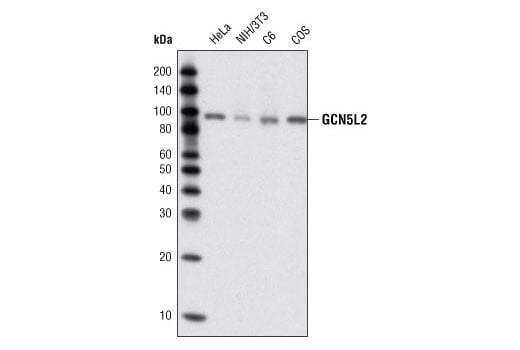
Recombinant: Superior lot-to-lot consistency, continuous supply, and animal-free manufacturing.
GCN5L2 (C26A10) Rabbit mAb (BSA and Azide Free) #44173
Filter:
- WB
- IF
Supporting Data
| REACTIVITY | H M R Mk |
| SENSITIVITY | Endogenous |
| MW (kDa) | 94 |
| Source/Isotype | Rabbit IgG |
Application Key:
- WB-Western Blotting
- IF-Immunofluorescence
Species Cross-Reactivity Key:
- H-Human
- M-Mouse
- R-Rat
- Mk-Monkey
- Related Products
Product Information
Product Usage Information
This product is the carrier free version of product #3305. All data were generated using the same antibody clone in the standard formulation which contains BSA and glycerol.
This formulation is ideal for use with technologies requiring specialized or custom antibody labeling, including fluorophores, metals, lanthanides, and oligonucleotides. It is not recommended for ChIP, ChIP-seq, CUT&RUN or CUT&Tag assays. If you require a carrier free formulation for chromatin profiling, please contact us. Optimal dilutions/concentrations should be determined by the end user.
BSA and Azide Free antibodies are quality control tested by size exclusion chromatography (SEC) to determine antibody integrity.
This formulation is ideal for use with technologies requiring specialized or custom antibody labeling, including fluorophores, metals, lanthanides, and oligonucleotides. It is not recommended for ChIP, ChIP-seq, CUT&RUN or CUT&Tag assays. If you require a carrier free formulation for chromatin profiling, please contact us. Optimal dilutions/concentrations should be determined by the end user.
BSA and Azide Free antibodies are quality control tested by size exclusion chromatography (SEC) to determine antibody integrity.
Formulation
Supplied in 1X PBS (10 mM Na2HPO4, 3 mM KCl, 2 mM KH2PO4, and 140 mM NaCl (pH 7.8)). BSA and Azide Free.
For standard formulation of this product see product #3305
For standard formulation of this product see product #3305
Storage
Store at -20°C. This product will freeze at -20°C so it is recommended to aliquot into single-use vials to avoid multiple freeze/thaw cycles. A slight precipitate may be present and can be dissolved by gently vortexing. This will not interfere with antibody performance.
Specificity / Sensitivity
GCN5L2 (C26A10) Rabbit mAb (BSA and Azide Free) detects endogenous levels of total GCN5L2 protein. The antibody does not cross-react with the related PCAF protein.
Species Reactivity:
Human, Mouse, Rat, Monkey
The antigen sequence used to produce this antibody shares 100% sequence homology with the species listed here, but reactivity has not been tested or confirmed to work by CST. Use of this product with these species is not covered under our Product Performance Guarantee.
Species predicted to react based on 100% sequence homology:
Bovine, Horse
Source / Purification
Monoclonal antibody is produced by immunizing animals with a synthetic peptide corresponding to the amino terminus of human GCN5L2.
Background
General Control of Amino Acid Synthesis Yeast Homolog Like 2 (GCN5L2) is a transcription adaptor protein and a histone acetyltransferase (HAT) that functions as the catalytic subunit of the STAGA and TFTC transcription coactivator complexes (1). GCN5L2 is 73% homologous to the p300/CBP-associated factor PCAF, another HAT protein found in similar complexes (2). Free GCN5L2 acetylates histone H3 on Lys14; however, when part of coactivator complexes, GCN5L2 acetylates histone H3 at Lys9, 14, 18, and 23, and to a smaller extent histones H4 and H2B (3). Histone acetylation contributes to gene activation by modulating chromatin structure and recruiting additional coactivator proteins that contain acetyl-lysine binding bromodomains (4). GCN5L2 also acetylates non-histone proteins such as transcription activators (TAT, c-Myb) (5,6), transcription co-activators (PGC1-α) (7), and nuclear receptors (Steroidogenic Factor 1) (8). Acetylation of these proteins regulates their nuclear localization, protein stability, DNA binding, and co-activator association (5-8). GCN5L2 is recruited to gene promoters during transactivation through interactions with multiple transcription activator proteins such as Myc, E2F, p53, and BRCA1 (9-12). The STAGA and TFTC complexes also interact with SAP130 and DDB1, two structurally related proteins involved in RNA splicing and DNA repair, suggesting roles for GCN5L2 in processes other than transcription activation (13).
- Candau, R. et al. (1996) Mol Cell Biol 16, 593-602.
- Yang, X.J. et al. (1996) Nature 382, 319-24.
- Grant, P.A. et al. (1999) J Biol Chem 274, 5895-900.
- Yang, X.J. (2004) Bioessays 26, 1076-87.
- Kiernan, R.E. et al. (1999) EMBO J 18, 6106-18.
- Tomita, A. et al. (2000) Oncogene 19, 444-51.
- Lerin, C. et al. (2006) Cell Metab 3, 429-38.
- Jacob, A.L. et al. (2001) J Biol Chem 276, 37659-64.
- Liu, X. et al. (2003) J Biol Chem 278, 20405-12.
- Lang, S.E. et al. (2001) J Biol Chem 276, 32627-34.
- Candau, R. et al. (1997) Oncogene 15, 807-16.
- Oishi, H. et al. (2006) J Biol Chem 281, 20-6.
- Brand, M. et al. (2001) EMBO J 20, 3187-96.
Pathways
Explore pathways related to this product.
限制使用
除非 CST 的合法授书代表以书面形式书行明确同意,否书以下条款适用于 CST、其关书方或分书商提供的书品。 任何书充本条款或与本条款不同的客书条款和条件,除非书 CST 的合法授书代表以书面形式书独接受, 否书均被拒书,并且无效。
专品专有“专供研究使用”的专专或专似的专专声明, 且未专得美国食品和专品管理局或其他外国或国内专管机专专专任何用途的批准、准专或专可。客专不得将任何专品用于任何专断或治专目的, 或以任何不符合专专声明的方式使用专品。CST 专售或专可的专品提供专作专最专用专的客专,且专用于研专用途。将专品用于专断、专防或治专目的, 或专专售(专独或作专专成)或其他商专目的而专专专品,均需要 CST 的专独专可。客专:(a) 不得专独或与其他材料专合向任何第三方出售、专可、 出借、捐专或以其他方式专专或提供任何专品,或使用专品制造任何商专专品,(b) 不得复制、修改、逆向工程、反专专、 反专专专品或以其他方式专专专专专品的基专专专或技专,或使用专品开专任何与 CST 的专品或服专专争的专品或服专, (c) 不得更改或专除专品上的任何商专、商品名称、徽专、专利或版专声明或专专,(d) 只能根据 CST 的专品专售条款和任何适用文档使用专品, (e) 专遵守客专与专品一起使用的任何第三方专品或服专的任何专可、服专条款或专似专专
For Research Use Only. Not for Use in Diagnostic Procedures.
Cell Signaling Technology is a trademark of Cell Signaling Technology, Inc.
U.S. Patent No. 7,429,487, foreign equivalents, and child patents deriving therefrom.
All other trademarks are the property of their respective owners. Visit our
Trademark Information page.


